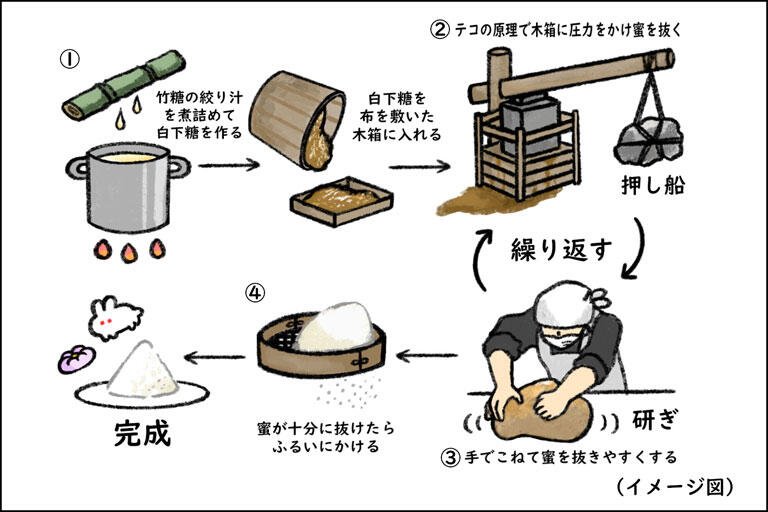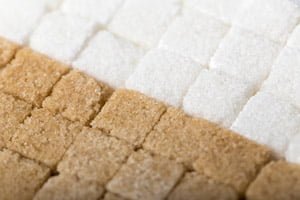The Sweet Secret of Wagashi: A History of Sugar in Japanese Confectionery
The world of wagashi (Japanese confectionery) is filled with a myriad of delightful flavors, but at its core lies a sweetness with a long history. Today, we’ll focus on sugar, an indispensable ingredient in wagashi, and unravel the history of Japanese flavors.
The Arrival of Sugar in Japan: The Beginning of Wagashi’s Transformation
Sugar was first introduced to Japan during the Nara period (710-794 AD). At that time, sugar brought from China by envoys was used as an ingredient in confections called “tōgashi” (Chinese sweets). However, due to its rarity, it remained out of reach for common people for a long time. From the Heian period to the Kamakura period, sugar was primarily used as medicine, with limited use as a general sweetener. During this era, wagashi was mainly sweetened with fruits and honey.
Edo Period: The Spread of Sugar and the Golden Age of Wagashi
As we entered the Edo period, the import volume of sugar increased dramatically. Dejima in Nagasaki Prefecture played a crucial role in this. Functioning as the sole trading port under the national isolation policy, Dejima became the center for sugar imports from the Netherlands and China. In the latter half of the 17th century, domestic sugar production also began. Sugar cane cultivation flourished, particularly in what are now Kagoshima and Okinawa prefectures, and unique Japanese sugar production techniques developed. With the spread of sugar, the world of wagashi underwent significant changes. More refined flavors and complex manufacturing methods gave birth to new wagashi one after another. Many wagashi that are still popular today originated during this period.
Types of Sugar and Wagashi: Creating Diverse Sweetness
The sugars used in wagashi are quite diverse. Let’s look at the main types and their characteristics:
| Sugar Type | Description |
|---|---|
| White sugar | The most common type of sugar, characterized by its high purity and neutral sweetness. It’s widely used in various wagashi. |
| Brown sugar | Made from sugar cane, it has a distinctive flavor and color. It’s often used in local confections like brown sugar manjū. |
| Mizuame (starch syrup) | A sweetener made by hydrolyzing starch, characterized by its high viscosity. It’s used for glazing and creating moist textures. |
| Wasanbon sugar | Used in the highest grade wagashi, it has a delicate sweetness and aroma due to its unique manufacturing method. Its taste dissolves smoothly in the mouth, leaving a subtle sweetness. It’s known for its low sweetness among sugars, creating an elegant sweet flavor. |
By using these different types of sugar, wagashi artisans create a variety of flavors and textures.
Wasanbon Sugar: Japan’s Finest Sugar
Wasanbon sugar is the highest grade sugar born in Sanuki (present-day Kagawa Prefecture) during the Edo period. Its production method is extremely labor-intensive and requires the skills of artisans.
There’s an interesting history behind why wasanbon sugar came to be produced in the Sanuki region. During the Edo period, Satsuma (present-day Kagoshima Prefecture) was the main sugar-producing region in Japan. However, it’s said that Hiraga Gennai, a senior retainer of the Sanuki domain lord Ikoma family, learned sugar production methods from Satsuma and brought them back to Sanuki.
At that time, Sanuki had an environment suitable for sugar cane cultivation, with the mild climate of the Seto Inland Sea and the use of former salt field sites. Additionally, the development of unique sugar refining techniques applying the methods used in Sanuki’s specialty washi paper production led to the birth of high-quality wasanbon sugar.
The wasanbon sugar manufacturing process is a very labor-intensive and delicate operation, roughly divided into four stages:
- Raw material preparation: Sugar cane is harvested from November to December and juiced. The juice is heated to remove impurities, filtered, and then boiled down until sufficiently concentrated. Upon cooling, it forms an amber-colored mixture of sugar crystals and liquid syrup called “shiroshitatō.”
- Syrup separation: The shiroshitatō is placed in a wooden box lined with layers of hemp and cotton cloth. Using a tool called an “oshifune,” pressure is applied using the principle of leverage with stone weights to squeeze out the liquid syrup.
- “Migaki” (polishing) process: The dehydrated shiroshitatō is taken out of the box, and a small amount of water is added before kneading by hand. This process, called “migaki,” makes the sugar particles finer and facilitates further syrup removal.
- Repetition of the process and finishing: Steps 2 and 3 are repeated as a set three to five times. Through repeated pressing with the “oshifune” and kneading in the “migaki” process, the wasanbon sugar becomes increasingly clear in color. Finally, it’s sieved and dried in the shade to complete the wasanbon sugar.
This unique method, especially the repetition of the process three times, is said to be the origin of the name “wasanbon.”

This meticulous production method gives wasanbon sugar a delicate sweetness and a melt-in-your-mouth texture that other sugars don’t have. Wasanbon sugar also contains more minerals compared to regular white sugar.
Wasanbon sugar is not only used in the highest grade wagashi but also plays an important role in the world of tea ceremony. Its refined sweetness harmonizes beautifully with the bitterness of matcha, deeply rooted in Japanese traditional culture.
The Role of Sugar: More Than Just Sweetness in Wagashi
Sugar plays various roles in wagashi, beyond just providing sweetness:
- Improving preservation: Sugar has an antibacterial effect, helping to extend the shelf life of wagashi.
- Texture adjustment: By changing the amount and type of sugar, various textures can be created, from moist to crispy.
- Color adjustment: Heating sugar can create caramel or amber colors, adjusting the appearance of wagashi.
- Adding aroma: High-grade sugars like wasanbon add unique aromas to wagashi.
- Anko (sweet bean paste) adjustment: Adding sugar when boiling beans like azuki helps create smooth anko.
Thus, sugar is a crucial ingredient that affects all aspects of wagashi – taste, appearance, aroma, and texture.
Conclusion: Carrying the History of Wagashi and Sugar into the Future
Sugar has evolved alongside wagashi culture since its introduction to Japan. Its history reflects not just its role as a sweetener, but also Japanese food culture and aesthetics.
While there’s a trend towards reducing sugar use due to health consciousness in modern times, sugar still plays a significant role in wagashi. The art of wagashi making continues to evolve, balancing traditional methods and flavors with the needs of the new era.
The next time you enjoy wagashi, try to sense the long history and artisan skills encapsulated in its sweetness. You’re sure to discover new depths of flavor.
